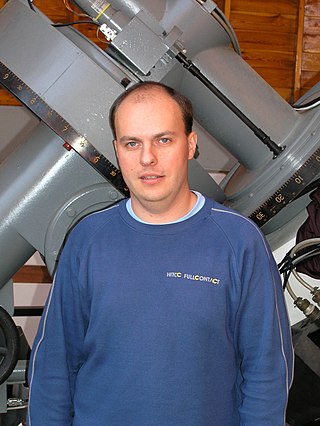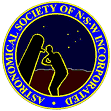Related Research Articles

Amateur astronomy is a hobby where participants enjoy observing or imaging celestial objects in the sky using the unaided eye, binoculars, or telescopes. Even though scientific research may not be their primary goal, some amateur astronomers make contributions in doing citizen science, such as by monitoring variable stars, double stars, sunspots, or occultations of stars by the Moon or asteroids, or by discovering transient astronomical events, such as comets, galactic novae or supernovae in other galaxies.

Astronomy is a natural science that studies celestial objects and the phenomena that occur in the cosmos. It uses mathematics, physics, and chemistry in order to explain their origin and their overall evolution. Objects of interest include planets, moons, stars, nebulae, galaxies, meteoroids, asteroids, and comets. Relevant phenomena include supernova explosions, gamma ray bursts, quasars, blazars, pulsars, and cosmic microwave background radiation. More generally, astronomy studies everything that originates beyond Earth's atmosphere. Cosmology is a branch of astronomy that studies the universe as a whole.

In astronomy, a light curve is a graph of the light intensity of a celestial object or region as a function of time, typically with the magnitude of light received on the y-axis and with time on the x-axis. The light is usually in a particular frequency interval or band.

Observational astronomy is a division of astronomy that is concerned with recording data about the observable universe, in contrast with theoretical astronomy, which is mainly concerned with calculating the measurable implications of physical models. It is the practice and study of observing celestial objects with the use of telescopes and other astronomical instruments.

The night sky is the nighttime appearance of celestial objects like stars, planets, and the Moon, which are visible in a clear sky between sunset and sunrise, when the Sun is below the horizon.

Konkoly Observatory is an astronomical observatory located in Budapest, Hungary is part of the Research Centre for Astronomy and Earth Sciences and belongs to the Eötvös Loránd Kutatási Hálózat. It was founded in 1871 by Hungarian astronomer Miklós Konkoly-Thege (1842–1916) as a private observatory, and was donated to the state in 1899. Konkoly Observatory, officially known as ELKH CSFK Konkoly Thege Miklós Csillagászati Intézet in Hungarian, is the largest astronomical research institute in Hungary, and hosts the largest telescopes in the country. The Observatory has more than 60 researchers, a quarter of them are non-Hungarian.

The Society for Popular Astronomy (SPA) is a national astronomical society based in the United Kingdom for beginners to amateur astronomy.
The Royal Astronomical Society of Canada (RASC) is a national, non-profit, charitable organization devoted to the advancement of astronomy and related sciences. At present, there are 30 local branches of the Society, called Centres, in towns and cities across the country from St. John's, Newfoundland, to Victoria, British Columbia, and as far north as Whitehorse, Yukon. There are about 5100 members from coast to coast to coast, and internationally. The membership is composed primarily of amateur astronomers and also includes numerous professional astronomers and astronomy educators. The RASC is the Canadian equivalent of the British Astronomical Association.

The International Year of Astronomy (IYA2009) was a year-long celebration of astronomy that took place in 2009 to coincide with the 400th anniversary of the first recorded astronomical observations with a telescope by Galileo Galilei and the publication of Johannes Kepler's Astronomia nova in the 17th century. The Year was declared by the 62nd General Assembly of the United Nations. A global scheme, laid out by the International Astronomical Union (IAU), was also endorsed by UNESCO, the UN body responsible for educational, scientific, and cultural matters.
The Association of Lunar and Planetary Observers is an international scientific and educational organization established in March 1947 in the United States by Walter H. Haas, and later incorporated in 1990. ALPO is an organization for advancing and conducting astronomical work by both professional and amateur astronomers who share an interest in Solar System observations. It is currently headquartered in Springfield, Illinois.

Kamil Hornoch is a Czech astronomer who discovered dozens of novae in nearby galaxies. The main belt asteroid 14124 Kamil is named in his honour.

Ursa Astronomical Association is the largest astronomical association in Finland. Ursa was founded on 2 November 1921. Founding members include a renowned Finnish astronomer Yrjö Väisälä. In 1926 Ursa established the Ursa Observatory in Kaivopuisto district of Helsinki. In 2007 the Tähtikallio Observatory & Education Center was established in Artjärvi, its current equipment includes an Astrofox 36" Folded Newtonian Open tube telescope, an Alluna 16" Ritchey-Chrétien telescope, a Meade 16" LX200GPS Schmidt-Cassegrain telescope, a Sky-Watcher ED 120mm refractor telescope fitted with a Baader AstroSolar Solar Filter and a piggybacked Coronado SolarMax 40 H-Alpha telescope. Ursa's primary functions include advancing amateur astronomy and astronomical education. They have also published a magazine Tähdet ja avaruus since 1971. Anyone can join Ursa for an annual fee.

The Givatayim Observatory is a public observatory that was founded in 1968 by the Israeli Astronomical Association and the Givatayim municipality.

Iso-Heikkilä Observatory is an amateur astronomical observatory used by a local amateur astronomical association, Turun Ursa ry in the Iso-Heikkilä district of Turku, Finland.

Astronomical Society Ruđer Bošković is an astronomical society in Belgrade, Serbia. Founded in 1934 by a group of students, it is the oldest one in the Balkans. Initially having only several members, today it gathers more than 700 astronomy lovers. It is named after Ruđer Bošković.

Walter Scott Houston was an American popularizer of amateur astronomy. He wrote the "Deep-Sky Wonders" column in Sky and Telescope magazine from 1946 to 1993.
Akashmitra Mandal is an amateur astronomers' organization in India. Its objective is to popularize astronomy and induce students, enthusiasts to make useful contributions in the field of astronomical research. It also aims to carry systematic study of the subject. It was the first organization in India to organize the amateur astronomers' Meet in India. Since its establishment in August 1986, many seminars, workshops, Basic Astronomy Courses for students and elders, Sky Watching Programmes were conducted by the organization. It has also enhanced the astronomical literature in India by publishing the "Directory of Persons Associated with Astronomy in India".

The Astronomical Society of New South Wales (ASNSW) is an amateur astronomy club in the state of New South Wales, Australia, founded in 1954.
References
- ↑ "The Ignited Minds... About Khagol Vishwa". Archived from the original on 2009-06-22. Retrieved 2009-02-02.
- ↑ "Archived copy". Archived from the original on 2009-11-27. Retrieved 2009-02-02.
{{cite web}}: CS1 maint: archived copy as title (link)